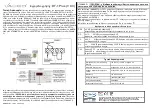TOF bit
CHnF bit
CNT
channel (n) output
MOD = 0x0008
CnV = 0x0005
counter
overflow
channel (n)
match
counter
overflow
...
0
1
2
3
4
5
6
7
8
0
1
2
...
previous value
Figure 27-44. EPWM signal with ELSnB:ELSnA = X:1
If (CnV = 0x0000), then the channel (n) output is a 0% duty cycle EPWM signal. If (CnV
> MOD), then the channel (n) output is a 100% duty cycle EPWM signal and CHnF bit is
not set since there is never a channel (n) match. Therefore, MOD must be less than
0xFFFF in order to get a 100% duty cycle EPWM signal.
27.4.7 Center-Aligned PWM (CPWM) Mode
The center-aligned mode is selected when (CPWMS = 1) and (MSnB:MSnA = 1:0).
The CPWM pulse width (duty cycle) is determined by 2 × CnV and the period is
determined by 2 × MOD (see the following figure). MOD must be kept in the range of
0x0001 to 0x7FFF because values outside this range can produce ambiguous results.
In the CPWM mode, the TPM counter counts up until it reaches MOD and then counts
down until it reaches zero.
The CHnF bit is set and channel (n) interrupt is generated (if CHnIE = 1) at the channel
(n) match (TPM counter = CnV) when the TPM counting is down (at the begin of the
pulse width) and when the TPM counting is up (at the end of the pulse width).
This type of PWM signal is called center-aligned because the pulse width centers for all
channels are when the TPM counter is zero.
The other channel modes are not designed to be used with the up-down counter (CPWMS
= 1). Therefore, all TPM channels should be used in CPWM mode when (CPWMS = 1).
Chapter 27 Timer/PWM Module (TPM)
KL02 Sub-Family Reference Manual, Rev. 2.1, July 2013
Freescale Semiconductor, Inc.
429

















